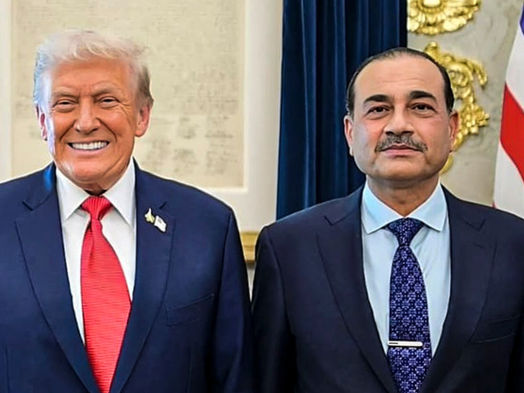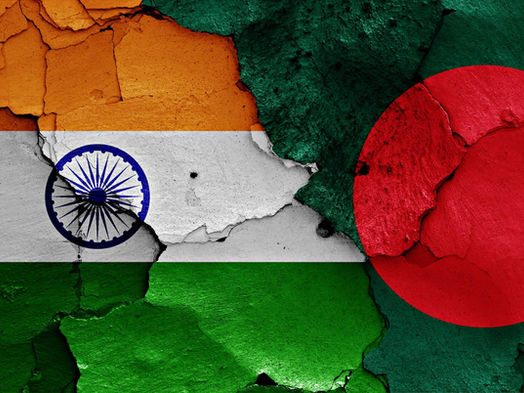top of page


00:50

00:54

00:59

25:20

01:02

00:53

01:01

00:48


Munir’s Gaza trap: Trump’s Peace Plan meets Pakistan’s street
Field Marshal Asim Munir has built his power on a deceptively simple proposition: Pakistan can be stabilised if the country submits to “order” first, politics later. In 2025, that proposition is colliding with a foreign-policy test that is designed to be lose-lose: President Donald Trump’s push for a Gaza “stabilisation” framework that would rely on troops from Muslim-majority countries. For Washington, it is an elegant political shield. For Islamabad, it is a domestic matchs


The hidden nexus: Why India must take heed
Recent global developments have once again drawn attention to the dangerous undercurrents in international extremist networks. A report echoed recently by officials from Israel warns that Hamas is increasingly deepening operational ties with Lashkar-e-Taiba (LeT), the Pakistan-based militant group designated as a terrorist organisation by many countries including India. Given the volatile regional dynamics, this warning deserves careful consideration. For both India’s intern


Pakistan Minority Commission: The weight of symbolism
The passage of Pakistan’s National Commission for Minorities’ Rights Bill on December 3, 2025, by a joint sitting of Parliament, represents yet another instance of the state signalling reform while ensuring that no substantive alteration occurs in the legal and ideological structures underpinning systemic discrimination. Approved with 160 votes in favour against 79 opposed, the legislation was stripped of its most consequential provisions – suo motu powers and an overriding-e


The Amjad Taha and Islamic Relief controversy: Why charities linked to foreign political movements need clear labels
In February 2025, Emirati political commentator Amjad Taha appeared on GB News’ Camilla Tominey Show and levelled explosive allegations against Islamic Relief, one of the UK’s most prominent Muslim charities. He claimed the organisation was funnelling money to terrorist groups in the Middle East. Within hours, the controversy dominated social media and triggered frantic political commentary. Islamic Relief initiated legal proceedings almost immediately. In September 2025, GB


US, Russia, and the great game of nuclear rhetoric
A month after Russia and the US declared their intentions of resuming nuclear testing, the global nuclear order and security landscape remains shrouded in uncertainty. This article analyses the ambiguity behind the threats and allegations of nuclear testing, the history of nuclear threat mongering between Russia and the United States, as well as the extent to which these developments are mere rhetoric or actual strategic signals. It has been a month since the threat of renew


India and Russia: Renewing an old friendship in a changing world
As Moscow and New Delhi prepare to host yet another high level diplomatic engagement, President Vladimir Putin’s official visit to India comes at a moment when the global order is undergoing a profound transformation. The unipolar moment that followed the Cold War has long faded; the United States’ overextended geopolitical influence is being challenged not only by emerging powers but by a wider coalition of states seeking autonomy, dignity, and genuine multipolarity. In this


The perils of glorifying Madvi Hidma: A terrorist's legacy of bloodshed and betrayal
In the wake of Madvi Hidma's death in an encounter with security forces on November 18, 2025, a disturbing trend has emerged: pockets of society attempting to lionize this notorious Maoist commander as a "revolutionary" or "Adivasi hero." Such glorification is not only misguided but dangerous, as it whitewashes the brutal reality of a man whose actions inflicted immense suffering on India. Hidma, the so-called "Ghost of Bastar," was no freedom fighter; he was a ruthless insur


The eastern threat returns: Why Bangladesh must act before terror networks take root again
A recent investigative report by DFRAC has raised alarms across the region, revealing how Pakistan-backed terror groups—most notably Lashkar-e-Taiba (LeT) and Jaish-e-Mohammad (JeM) are quietly rebuilding ideological and organisational networks inside Bangladesh. These revelations are not mere academic concerns; they represent a real and immediate threat to regional stability, India’s internal security, and Bangladesh’s own socio-political fabric. According to the DFRAC repor


Coordinated propaganda network in Bangladesh targets India through digital disinformation
A detailed examination of Bangladesh’s digital space has revealed the presence of a highly coordinated online ecosystem pushing anti-India narratives through fabricated military claims, politicized misinformation, and aggressive rhetoric. Operating across Facebook, YouTube, and X, these accounts pose as media outlets but function primarily as propaganda platforms aimed at undermining India–Bangladesh relations and fuelling distrust between the two neighbours. In recent years,


A landmark NatStrat chronicle exposes Pakistan’s 78-year terror blueprint against India
The latest NatStrat publication, “Chronology of Pakistani Terror Attacks on India (1947–2025)”, edited by Dr. Swati Arun and guided by NatStrat Advisor Mr. Shantanu Mukharji (IPS) former NSA to Prime Minister of Mauritius, and Convener Ambassador Pankaj Saran, stands out as one of the most exhaustive and authoritative chronicles of Pakistan-backed terrorism ever compiled in the Indian strategic space. It is not merely a record it is a powerful reminder of how a neighbouring s


Mumbai 26/11 at seventeen: Memory, justice and the end of impunity
Seventeen years have passed since the night of 26 November 2008, when Mumbai—India’s largest, loudest, and most restless city—suddenly found itself under siege. What started as the ordinary hum of a weekday evening quickly turned into a theatre of violence as ten heavily armed terrorists landed on the city’s shoreline and began a coordinated series of attacks that would last nearly sixty hours. By the morning of 29 November, 166 people had been killed, and more than 300 other


The EU must not renew Pakistan’s GSP+ status: Europe cannot keep underwriting a rogue state
As Brussels reviews Pakistan’s GSP+ trade privileges, the question before the European Union is not technical, economic, or procedural, it is profoundly moral. Renewing GSP+ for Pakistan would not uplift human rights, encourage democratic reform, or strengthen civil society. Instead, it would reward a collapsing state apparatus that systematically violates the very 27 UN conventions that GSP+ is designed to enforce. For a decade, Europe has granted Pakistan tariff-free access


Naxalism Is being erased – But India cannot afford amnesia
For half a century, the word “Naxal” evoked a chilling image: ambushed convoys, torched schools, kangaroo courts in forest clearings, and entire districts where the Indian state existed only on paper. Today, that image is collapsing at unprecedented speed. What was once called the “Red Corridor” is now a shrinking archipelago of violence, boxed into a few pockets, hunted on a war footing, and steadily replaced by roads, mobile towers and police posts. This is not rhetoric. It


Shared Himalayan Climate Threat
Climate change is transforming the Himalayas into a zone of escalating risk, endangering shared rivers, infrastructure and livelihoods across Nepal and India. Only a deeper, science-driven partnership can turn this growing vulnerability into long-term regional resilience. The Himalayas, often called the “Third Pole” for their vast store of ice and snow, are melting faster than ever. The consequences of this fundamental shift in the climate system extend across South Asia, res


The 27th Constitutional Amendment – institutionalising military supremacy in Pakistan?
Pakistan's 27th Constitutional Amendment Bill, passed on November 8, 2025, marks a decisive transformation in the country's power structure, formally entrenching the military's dominance within the constitutional framework. File photo of Field Marshal Asim Munir. The amendment establishes the Chief of Defence Forces (CDF), unifying command over the Army, Navy, and Air Force, while abolishing the Chairman, Joint Chiefs of Staff Committee. Though presented as a measure to enhan


Tehreek-e-Labbaik Pakistan Force – another self-inflicted wound
Pakistan appears to be in the process of creating another Frankensteinian monster for itself. Elements within the Tehreek-e-Labbaik Pakistan (TLP) , long a protégé of the military establishment and mobilized from time to time to embarrass or pressure the political leadership, appear to have gone rogue — raising an armed formation, the Tehreek-e-Labbaik Pakistan Force (TLPF) . File photo. In the wake of the brutal repression of the TLP’s ‘Labbaik Ya Aqsa Million March’ protes


Will anti-Indianism spread across the Anglosphere?
Introduction Since the 2024 U.S. elections, amid global economic headwinds—rising inflation, housing shortages, and labour-market disruption— there has been an increasing wave of anti-Indian sentiment , sometimes called anti-Indianism, Hinduphobia, or Indophobia. This describes prejudice, hostility, or discrimination directed at people of Indian origin, including both immigrants and long-established diaspora communities. (AI-generated photo .) What makes this trend significan


Bangladesh – HeI: Resurgent Islamism
On October 29, 2025, Hefazat-e-Islam (HeI) Khagrachari District branch formed a human chain to protest and demand a ban on the International Society for Krishna Consciousness (ISKCON), claiming that it was an extremist Hindutva organisation. On October 24, 2025, HeI staged a protest rally in Chittagong District, demanding a ban on ISKCON, describing it as an extremist Hindutva organisation and an Indian agent. On October 18, 2025, Local Government, Rural Development and Coope


Nepal – from the streets to the ballot
On October 29, 2025, Nepal’s Supreme Court Constitutional Bench declined to issue an interim order against the formation of the government led by Prime Minister Sushila Karki and the dissolution of the House of Representatives, paving the way for elections scheduled on March 5, 2026. This followed the September 12, 2025, dissolution of Parliament and the appointment of an interim administration amid widespread unrest, including student-led Gen Z protests that highlighted mas


Bipin Joshi and the Missing Global Hindu Voice
In Bipin Joshi’s captivity, we glimpse the quiet absence of a global Hindu voice. After two years in Hamas captivity, Bipin Joshi is finally home, and his ātmā has attained sadgati . His mortal remains were repatriated from Israel last week. At Ben Gurion Airport, the Israeli foreign ministry held a farewell ceremony attended by locals and foreign citizens; at the Tribhuvan International Airport in Kathmandu, Nepal’s interim Prime Minister Sushila Karki draped the national f
bottom of page




